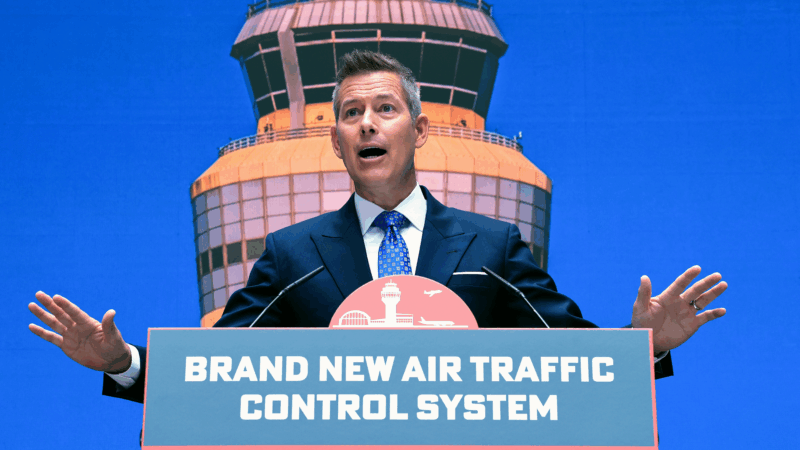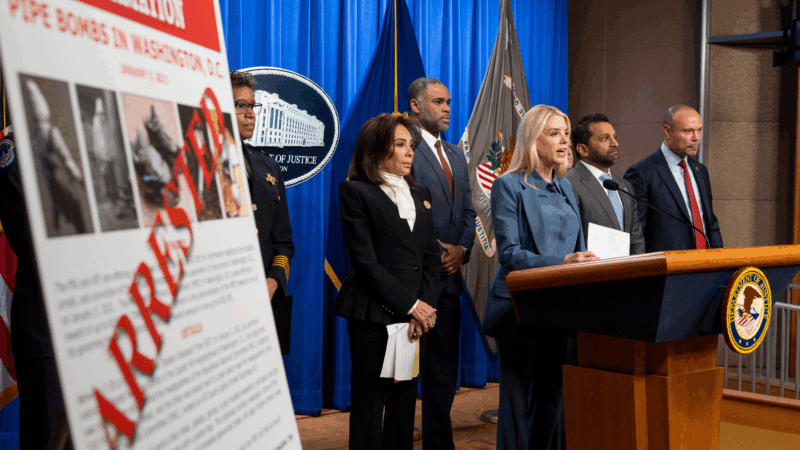Trump administration unveils a plan to modernize the air traffic control system
Transportation Secretary Sean Duffy says he wants a full modernization of the nation’s antiquated air traffic control system within four years. On Thursday, he announced a far-reaching, estimated multibillion-dollar plan that would drastically overhaul the current technology used by thousands of controllers responsible for guiding planes in and out of airports.
Duffy and other Trump administration officials unveiled the ambitious modernization plan after several days of turmoil at Newark Liberty International Airport, one of the nation’s busiest.
“A lot of people have said: This problem is too complicated, too expensive, too hard,” Duffy said at an event at Department of Transportation headquarters in Washington, D.C. “But we are blessed to have a president who actually loves to build and knows how to build.”
He said President Trump “doesn’t want to pass this problem to the next administration, the next secretary, or the next set of victims.”
Duffy was cagey about saying what this plan will cost. The House Transportation and Infrastructure Committee estimated last week that it might cost $12.5 billion to modernize the air traffic control system. Duffy said he estimates this project will cost more than that.
The Modern Skies Coalition, a group of aviation industry experts, pilot association representatives and others, issued a statement saying they believe a minimum of $18.5 billion in additional emergency funding (on top of the $12.5 billion figure being floated) should be appropriated over the next three years. And that’s in addition to FAA’s annual technologies and facilities budget.
The DOT is proposing to replace the existing decades-old telecommunications, radio and surveillance systems (which currently rely on things like copper wires and floppy disks) with modern technology. The plan also includes investing in new ground radar sensors on tarmacs and at airports, a new flight management system and some new air traffic control towers and other facilities, Duffy said.
The plan will need approval from Congress and to get this done within four years, the secretary is requesting Congress provide the funding up front, rather than incrementally. Trump has endorsed the plan, even joining Duffy at the press conference via speakerphone.
Airline executives and trade representatives attended the plan’s unveiling, expressing full backing of the proposal.
“We can’t kick the can down the road. We need to do it now,” said Nicholas Calio, president and CEO of Airlines for America, a trade association for the aviation industry.

The plan comes after years of mounting problems at airports and a series of incidents just this year.
In January, the midair collision of an Army Black Hawk helicopter and a commercial airliner near Ronald Reagan Washington National Airport (known by the airport code DCA) led to the deadliest aviation accident in the U.S. since 2001. In the months since, multiple close calls and other crashes, as well as technology failures that led to delays and cancellations at Newark airport spurred officials to act.
National Transportation Safety Board Chairwoman Jennifer Homendy expressed full support for the plan saying, “An aging system poses an untenable risk to safety. I said it after DCA, I’ll say it again now: an untenable risk to safety.”
How does the chaos at Newark Airport fit into this?
Bad weather, the months long renovation of one of Newark’s busiest runways for departing flights and a shortage of air traffic controllers have led to more than a week of of long delays and cancellations at the airport.
On April 28, air traffic controllers stationed at the Philadelphia Terminal Radar Approach Control facility, which is responsible for separating and sequencing planes in and out of Newark, lost all radar and communications with planes, leaving them unable to hear or talk to the pilots for at least 30 seconds. Some controllers took leave “to recover from the stress of multiple recent outages,” the Federal Aviation Administration said in a statement.
The chaos at Newark helped highlight the aging air traffic technology the industry relies on and spurred officials to do more.
To address the situation, the FAA this week announced several changes, including introducing three “new, high-bandwidth telecommunications connections” between the New York station that processes radar data and the Philadelphia location where controllers handle Newark’s arrivals and departures. The old, copper telecommunications connections will get a fiber-optic technology update, allowing for greater bandwidth and speed, the agency said.
Stephen Creamer, the president & CEO of the Air Traffic Control Association, an industry group, said he was encouraged by the administration’s commitment to vital upgrades and bipartisan support in Congress. “Today was all about leadership. It was all about political purpose and will — setting the stage for all of those plans to be built,” he said.
“They’ve taken advantage of recommendations from across the industry,” he added. “Now, with political support, they have the shot in the arm they need to get this done.”
Last week, Duffy announced a new recruitment award and retention incentive program to boost hiring of controllers. But staffing is not part of this new, wider proposal introduced Thursday.
A history of problems
Following the recent chaos at Newark, the Trump administration has railed against former President Joe Biden and former Transportation Secretary Pete Buttigieg, blaming them for the issues with the air traffic control system.
Trump took to his Truth Social account Thursday to say: “Air Traffic problems caused by the incompetent Biden Administration, as headed by, in this case, a total novice and political hack, Pete B. I WILL FIX IT!!!”
During his first term, Trump discussed possible solutions — including privatizing air traffic control — that went nowhere.
After taking office for the second time, the Trump administration laid off hundreds of FAA employees as part of a federal effort to cut back on workers. Officials said controllers and other “critical safety personnel” were not among those laid off.
But problems with the civilian aviation industry did not start with Newark, the Jan. 29 crash at DCA or the Biden administration.
Airlines and unions have called on the government to do more for decades.
Under the Biden administration, Buttigieg asked Congress to provide more funding to hire thousands of new air traffic controllers. House Republicans blocked that effort.
In September, the Government Accountability Office said the FAA needed to make drastic changes, and fast, to fix the aging air traffic control system.
The report found that in the previous year, the FAA determined more than a third of its systems “are unsustainable, citing outdated functionality, a lack of spare parts, and more.” The report said most modernization projects won’t be completed for another 10-13 years.
Robert W. Mann Jr., an aviation industry analyst, who spoke to NPR earlier this week about the disruptions at Newark, expressed skepticism that a new system will be built.
“This has been the same mantra for the past 30 years. Give them more money. They’ll build the new system. It’ll work better, work harder. And this is what airlines tell the FAA. This is what the FAA says they want to do each time the agency comes up for reauthorization. And we’ve been doing that for well over 30 years now, and we’ve gotten the same results,” Mann said.
Sheldon Jacobson, a University of Illinois professor who has studied risks in aviation, says that the system works remarkably well as is. But he agrees that an upgrade is critical.
Still, he points out that the pilot error accounts for three-quarters of all aviation incidents. “Would improving ATC reduce that? I don’t think it would.”
Jacobson also says he believes the administration’s plan isn’t forward-thinking enough. “There’s a void there.” Artificial intelligence could take on a lot of mundane air-traffic control chores that now require a human — such as getting planes away from the gate, he says.
Pipe bomb suspect told FBI he targeted U.S. political parties, memo says
The man accused of placing two pipe bombs in Washington on the eve of Jan. 6, 2021 told investigators someone needed to "speak up" for people who believed the 2020 election was stolen, prosecutors said Sunday.
Chinese military stages drills around Taiwan to warn ‘external forces’
The drills came after Beijing expressed anger at U.S. arms sales, and a statement by Japan's prime minister saying its military could get involved if China were to take action against Taiwan.
Trump and Netanyahu to meet in Florida at a crucial moment for the Gaza ceasefire
President Trump could use the face-to-face at his Mar-a-Lago estate to look for ways to speed up the peace process, as Israel's leader has been accused of not pushing his side to move fast enough.
‘Bomb cyclone’ forecasted to bring heavy snow, blizzard conditions and dangerous travel
A 'bomb cyclone' is intensifying severe winter weather for millions of people across the U.S. The system is expected to knock out power and disrupt holiday travel.
Russia sends 3 Iranian satellites into orbit, report says
The report said that a Russian rocket sent the satellites on Sunday from a launchpad in eastern Russia.
Viral global TikToks: A twist on soccer, Tanzania’s Charlie Chaplin, hope in Gaza
TikToks are everywhere (well, except countries like Australia and India, where they've been banned.) We talk to the creators of some of the year's most popular reels from the Global South.








